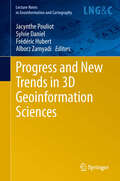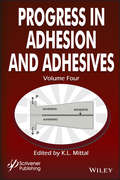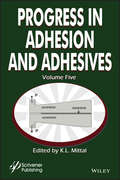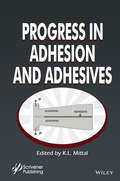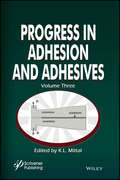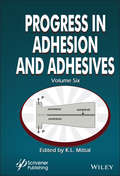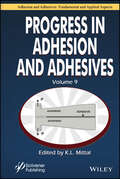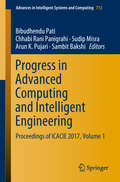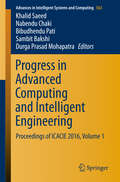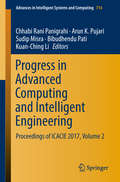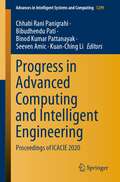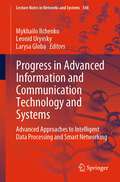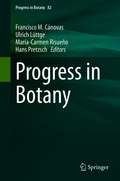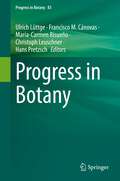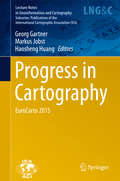- Table View
- List View
Progress and Challenge of Porous Media: Proceedings of the 16th Annual Meeting Conference on Porous Media
by Lei Zhang Jun Yao Kai Zhang Hai Sun Yongfei Yang Wendong WangThis book is a compilation of selected papers from the 16th Annual Meeting Conference on Porous Media (InterPore 2024). The work focuses on novel techniques for porous media materials, transport mechanisms in porous media, multiscale multiphysics, pore-scale modeling, and porous media mechanics. The contents make valuable contributions to academic researchers, engineers in the industry, and regulators of aviation authorities. As well, readers will encounter new ideas for problems in porous media science and engineering.
Progress and New Trends in 3D Geoinformation Sciences
by Alborz Zamyadi Frédéric Hubert Jacynthe Pouliot Sylvie DanielThe integration of the 3rd dimension in the production of spatial representation is largely recognized as a valuable approach to comprehend our reality, that is 3D. During the last decade developments in 3D Geoinformation (GI) system have made substantial progress. We are about to have a more complete spatial model and understanding of our planet in different scales. Hence, various communities and cities offer 3D landscape and 3D city models as valuable source and instrument for sustainable management of rural and urban resources. Also municipal utilities, real estate companies benefit from recent developments related to 3D applications. In order to present recent developments and to discuss future trends, academics and practitioners met at the 7th International Workshop on 3D Geoinformation. This book comprises a selection of evaluated, high quality papers that were presented at this workshop in May 2012. The topics focus explicitly on the last achievements (methods, algorithms, models, systems) with respect to 3D GeoInformation requirements. The book is aimed at decision makers and experts as well at students interested in the 3D component of geographical information science including GI engineers, computer scientists, photogrammetrists, land surveyors, urban planners, and mapping specialists.
Progress in Adhesion Adhesives (Adhesion And Adhesives: Fundamental And Applied Aspects Ser.)
by K. L. MittalWith the ever-increasing amount of research being published, it is a Herculean task to be fully conversant with the latest research developments in any field, and the arena of adhesion and adhesives is no exception. Thus, topical review articles provide an alternate and very efficient way to stay abreast of the state-of-the-art in many subjects representing the field of adhesion science and adhesives. Based on the success of the preceding volumes in this series “Progress in Adhesion and Adhesives”), the present volume comprises 9 review articles (averaging 50 pages each) published in Volume 6 (2018) of Reviews of Adhesion and Adhesives. The topics covered include: Adhesion Phenomena Pertaining to Thermal Interface Materials and Solder Interconnects in Microelectronic Packaging; Influence of Silicon-Containing Compounds on Adhesives for and Adhesion to Wood and Lignocellulosic Materials; Recent Advances in Adhesively Bonded Lap Joints Having Bi-Adhesive and Modulus-Graded Bondlines; Adhesion between Compounded Elastomers; Contact Angle Measurements and Applications in Pharmaceuticals and Foods; Groups at Polyolefin Surfaces on Exposure to Oxygen or Ammonia Plasma; Surface Free Energy Determination of Powders and Particles with Pharmaceutical Applications; Understanding Wood Bonds–Going Beyond What Meets the Eye; Dispersion Adhesion Forces between Macroscopic Objects–Basic Concepts and Modelling Techniques.
Progress in Adhesion Adhesives, Volume 5 (Adhesion And Adhesives: Fundamental And Applied Aspects Ser.)
by K. L. MittalWith the ever-increasing amount of research being published, it is a Herculean task to be fully conversant with the latest research developments in any field, and the arena of adhesion and adhesives is no exception. Thus, topical review articles provide an alternate and very efficient way to stay abreast of the state-of-the-art in many subjects representing the field of adhesion science and adhesives. Based on the success of the preceding volumes in this series “Progress in Adhesion and Adhesives”, the present volume comprises 13 review articles published in Volume 7 (2019) of Reviews of Adhesion and Adhesives. The subjects of these review articles fall into the following areas: Adhesively bonded joints Adhesives (including bioadhesives) and their applications Nanocomposite polymer adhesives Polymer surface modification Wettability and surface free energy Adhesion of bacteria The topics covered include: Adhesion behavior of plasma treated steel and its alloys; debonding on demand of adhesively bonded joints; bioadhesive polymers; adhesives in the footwear industry; nanocomposite polymer adhesives; ion beam treatment of polymer surfaces to enhance adhesion; natural to artificial non-wettable surfaces and applications; plasma oxidation of polyolefins; wettability and surface free energy characterization of textiles; bioadhesive nanoformulations; laser-assisted tailoring of surface wettability; functionally graded adhesively bonded joints; adhesion of colloids and bacteria to porous media.
Progress in Adhesion and Adhesives
by K. L. MittalThis book is based on the 13 review articles written by subject experts and published in 2014 in the Journal Reviews of Adhesion and Adhesives. The rationale for publication of this book is that currently the RAA has limited circulation, so this book provides broad exposure and dissemination of the concise, critical, illuminating, and thought-provoking review articles. The subjects of the reviews fall into 4 general areas: 1. Polymer surface modification 2. Biomedical, pharmaceutical and dental fields 3. Adhesives and adhesive joints 4. General Adhesion Aspects The topics covered include: Adhesion of condensed bodies at microscale; imparting adhesion property to silicone material; functionally graded adhesively bonded joints; synthetic adhesives for wood panels; adhesion theories in wood adhesive bonding; adhesion and surface issues in biocomposites and bionanocomposites; adhesion phenomena in pharmaceutical products and applications of AFM; cyanoacrylate adhesives in surgical applications; ways to generate monosort functionalized polyolefin surfaces; nano-enhanced adhesives; bonding dissimilar materials in dentistry; flame treatment of polymeric materials--relevance to adhesion; and mucoadhesive polymers for enhancing retention of ocular drug delivery.
Progress in Adhesion and Adhesives
by K. L. MittalWith the ever-increasing amount of research being published it is a Herculean task to be fully conversant with the latest research developments in any field, and the arena of adhesion and adhesives is no exception. Thus, topical review articles provide an alternate and very efficient way to stay abreast of the state-of-the-art in may subjects representing the field of adhesion science and adheisves. Based on the success and the warm reception accorded to the premier volume in this series “Progress in Adhesion and Adhesives” (containing the review articles published in Volume 2 (2014) of the journal Reviews of Adhesion and Adhesives (RAA)), volume 2 comprises 14 review articles published in Volume 4 (2016) of RAA. The subjects of these 14 reviews fall into the following general areas: 1. Surface modification of polymers for a variety of purposes. 2. Adhesion aspects in reinforced composites 3. Thin films/coatings and their adhesion measurement 4. Bioadhesion and bio-implants 5. Adhesives and adhesive joints 6. General adhesion aspects The topics covered include: surface modification of natural fibers for reinforced polymer composites; adhesion of submicrometer thin metals films; surface treatments to modulate bioadhesion; hot-melt adhesives from renewable resources; particulate-polymer composites; functionally graded adhesively bonded joints; fabrication of nano-biodevices; effects of particulates on contact angles , thermal stresses in adhesively bonded joints and ways to mitigate these; laser-assisted electroless metallization of polymer materials; adhesion measurement of coatings on biodevices/implants; cyanoacrylate adhesives; and adhesion of green flame retardant coatings onto polyolefins.
Progress in Adhesion and Adhesives (Adhesion And Adhesives: Fundamental And Applied Aspects Ser.)
by K. L. MittalWith the ever-increasing amount of research being published, it is a Herculean task to be fully conversant with the latest research developments in any field, and the arena of adhesion and adhesives is no exception. Thus, topical review articles provide an alternate and very efficient way to stay abreast of the state-of-the-art in many subjects representing the field of adhesion science and adhesives. Based on the success of the preceding volumes in this series “Progress in Adhesion and Adhesives”), the present volume comprises 12 review articles published in Volume 5 (2017) of Reviews of Adhesion and Adhesives. The subject of these 12 reviews fall into the following general areas. Nanoparticles in reinforced polymeric composites. Wettability behavior and its modification, including superhydrophobic surfaces. Ways to promote adhesion, including tuber adhesion. Adhesives and adhesive joints Dental adhesion. The topics covered include: Nanoparticles as interphase modifiers in fiber reinforced polymeric composites; fabrication of micro/nano patterns on polymeric substrates to control wettability behavior; plasma processing of aluminum alloys to promote adhesion; UV-curing of adhesives; functionally graded adhesively bonded joints; adhesion between unvulgarized elastomers; electrowetting for digital microfluidics; control of biofilm at the tooth-restoration bonding interface; easy-to-clean superhydrophobic coatings; cyanoacrylates; promotion of resin-dentin bond longevity in adhesive dentistry; and effects of nanoparticles on nanocomposites Mode I and Mode II fractures.
Progress in Adhesion and Adhesives, Volume 6 (Adhesion and Adhesives: Fundamental and Applied Aspects)
by K. L. MittalWith the ever-increasing amount of research being published, it is a Herculean task to be fully conversant with the latest research developments in any field, and the arena of adhesion and adhesives is no exception. Thus, topical review articles provide an alternate and very efficient way to stay abreast of the state-of-the-art in many subjects representing the field of adhesion science and adhesives.
Progress in Adhesion and Adhesives, Volume 7 (Adhesion And Adhesives: Fundamental And Applied Aspects Ser.)
by K. L. MittalThe current book contains eight commissioned chapters and cover topics including stress distribution and design analysis of adhesively bonded tubular composite joints; durability of structural adhesive joints; mechanical surface treatment of adherends for adhesive bonding; surface modification of polymer materials by excimer UV light; corona discharge treatment of materials to enhance adhesion; adhesion activation of aramid fibers; dual-cured hydrogels for bioadhesives and biomedical applications; and non-adhesive SLIPS-like surfaces.
Progress in Adhesion and Adhesives, Volume 8 (Adhesion and Adhesives: Fundamental and Applied Aspects)
by K. L. MittalKeep up-to-date with the latest on adhesion and adhesives from an expert group of worldwide authors. The book series “Progress in Adhesion and Adhesives” was conceived as an annual publication and the premier volume made its debut in 2015. The series has been well-received as it is unique and provides substantive and curated review chapters on subjects that touch many disciplines. The current book contains nine chapters on topics that include multi-component theories in surface thermodynamics and adhesion science; plasma-deposited polymer layers as adhesion promotors; functional interlayers to control interfacial adhesion in reinforced polymer composites; hydrophobic materials, and coatings from natural sources; mechanics of ice adhesion; epoxy adhesives technology: latest developments and trends; hot-melt adhesives for automobile assembly; lifetime estimation of thermostat adhesives by physical and chemical aging processes; and nondestructive evaluation and condition monitoring of adhesive joints. Audience The volume will appeal to adhesionists, adhesive technologists, polymer scientists, materials scientists, and those involved/interested in adhesive bonding, plasma polymerization, adhesion in polymer composites, durability and testing of adhesive joints, materials from natural sources, and ice adhesion and mitigation.
Progress in Adhesion and Adhesives, Volume 9
by K. L. MittalThe present book constitutes Volume 9 in the book series Progress in Adhesion and Adhesives which was conceived as an annual publication and the premier volume made its debut in 2015. These volumes provide state-of-the-knowledge and curated reviews on many and varied topics about adhesion and adhesives. The current book contains 14 chapters that include the use of hydrophobic and icephobic coatings for aircraft icing mitigations; fundamental concepts and the application of hydrophobic coatings; plasma treatment of polymers to enhance their adhesion; atmospheric pressure plasma treatment of artificial leather; sustainable plasma technology as a surface treatment in footwear materials; failure cases in adhesive joints and coatings; initiating systems for curing anaerobic adhesives; use of fungal mycelia as an adhesive in composites; mechanically responsive hydrogels as adhesives for clinical applications; and adhesion of electrode coatings in lithium-ion batteries and supercapacitors.
Progress in Advanced Computing and Intelligent Engineering: Proceedings Of Icacie 2017, Volume 2 (Advances in Intelligent Systems and Computing #714)
by Sudip Misra Bibudhendu Pati Sambit Bakshi Chhabi Rani Panigrahi Arun K. PujariThe book gathers high-quality research papers presented at the International Conference on Advanced Computing and Intelligent Engineering (ICACIE 2017). It includes technical sections describing progress in the fields of advanced computing and intelligent engineering, and is primarily intended for postgraduate students and researchers working in Computer Science and Engineering. However, researchers working in Electronics will also find the book useful, as it addresses hardware technologies and next-gen communication technologies.
Progress in Advanced Computing and Intelligent Engineering: Proceedings of ICACIE 2016, Volume 1 (Advances in Intelligent Systems and Computing #563)
by Khalid Saeed Nabendu Chaki Durga Prasad Mohapatra Bibudhendu Pati Sambit BakshiThe book focuses on both theory and applications in the broad areas of communication technology, computer science and information security. This two volume book contains the Proceedings of International Conference on Advanced Computing and Intelligent Engineering. These volumes bring together academic scientists, professors, research scholars and students to share and disseminate information on knowledge and scientific research works related to computing, networking, and informatics to discuss the practical challenges encountered and the solutions adopted. The book also promotes translation of basic research into applied investigation and convert applied investigation into practice.
Progress in Advanced Computing and Intelligent Engineering: Proceedings of ICACIE 2017, Volume 2 (Advances in Intelligent Systems and Computing #714)
by Sudip Misra Kuan-Ching Li Bibudhendu Pati Chhabi Rani Panigrahi Arun K. PujariThis book features high-quality research papers presented at the International Conference on Advanced Computing and Intelligent Engineering (ICACIE 2017). It includes sections describing technical advances in the fields of advanced computing and intelligent engineering, which are based on the presented articles. Intended for postgraduate students and researchers working in the discipline of computer science and engineering, the proceedings also appeal to researchers in the domain of electronics as it covers hardware technologies and future communication technologies.
Progress in Advanced Computing and Intelligent Engineering: Proceedings of ICACIE 2019, Volume 1 (Advances in Intelligent Systems and Computing #1198)
by Rajkumar Buyya Kuan-Ching Li Bibudhendu Pati Chhabi Rani Panigrahi Prasant MohapatraThis book features high-quality research papers presented at the 4th International Conference on Advanced Computing and Intelligent Engineering (ICACIE 2019), Department of Computer Science, Rama Devi Women’s University, Bhubaneswar, Odisha, India. It includes sections describing technical advances and contemporary research in the fields of advanced computing and intelligent engineering, which are based on the presented articles. Intended for postgraduate students and researchers working in the discipline of computer science and engineering, the book also appeals to researchers in the domain of electronics as it covers hardware technologies and future communication technologies.
Progress in Advanced Computing and Intelligent Engineering: Proceedings of ICACIE 2019, Volume 2 (Advances in Intelligent Systems and Computing #1199)
by Rajkumar Buyya Kuan-Ching Li Bibudhendu Pati Chhabi Rani Panigrahi Prasant MohapatraThis book features high-quality research papers presented at the 4th International Conference on Advanced Computing and Intelligent Engineering (ICACIE 2019), Department of Computer Science, Rama Devi Women’s University, Bhubaneswar, Odisha, India. It includes sections describing technical advances and contemporary research in the fields of advanced computing and intelligent engineering, which are based on the presented articles. Intended for postgraduate students and researchers working in the discipline of computer science and engineering, the book also appeals to researchers in the domain of electronics as it covers hardware technologies and future communication technologies.
Progress in Advanced Computing and Intelligent Engineering: Proceedings of ICACIE 2020 (Advances in Intelligent Systems and Computing #1299)
by Kuan-Ching Li Bibudhendu Pati Chhabi Rani Panigrahi Binod Kumar Pattanayak Seeven AmicThis book focuses on theory, practice and applications in the broad areas of advanced computing techniques and intelligent engineering. This book includes 74 scholarly articles which were accepted for presentation from 294 submissions in the 5th ICACIE during 25–27 June 2020 at Université des Mascareignes (UdM), Mauritius, in collaboration with Rama Devi Women’s University, Bhubaneswar, India, and S‘O’A Deemed to be University, Bhubaneswar, India. This book brings together academicians, industry persons, research scholars and students to share and disseminate their knowledge and scientific research work related to advanced computing and intelligent engineering. It helps to provide a platform to the young researchers to find the practical challenges encountered in these areas of research and the solutions adopted. The book helps to disseminate the knowledge about some innovative and active research directions in the field of advanced computing techniques and intelligent engineering, along with some current issues and applications of related topics.
Progress in Advanced Information and Communication Technology and Systems: Advanced Approaches to Intelligent Data Processing and Smart Networking (Lecture Notes in Networks and Systems #548)
by Mykhailo Ilchenko Leonid Uryvsky Larysa GlobaThis book highlights the most important research areas in information and communication technologies, namely the research in fields of modern information technologies that deal with various aspects of the analysis and solution of practically important issues of information systems in general, and contains discussion about the progression from big data to smart data, development of cloud-based architecture, practical implementation of Internet of Things (IoT), the fundamentals of information and analytical activities; studying of modern communication technologies contains original works dealing with many aspects of construction, using research and forecasting of technological and services characteristics of communication systems, as well as research of modern radio electronics technologies that contains actual papers, which show some effective technological solutions that can be used for the implementation of novel radio electronics systems. These results can be used in the implementation of novel systems and to promote information exchange in e-societies. This book offers a valuable resource for scientists, lecturers, specialists working at enterprises, and graduate and undergraduate students who engage with problems in information and communication technologies.
Progress in Advanced Structural and Functional Materials Design
by Tomoyuki KakeshitaThis book describes clearly various research topics investigated for these 10 years in the Research Center of Advanced Structural and Functional Materials Design in Osaka University, Japan. Every chapter is aimed at understanding most advanced researches in materials science by describing its fundamentals and details as much as possible. Since both general explanations and cutting-edge commentaries are given for each topic in this book, it provides a lot of useful information for ordinary readers as well as materials scientists & engineers who wish to understand the future development in materials science fields of metals, alloys, ceramics, semiconductors etc. In particular, this book deals with special fusion area of structural and functional materials such as medical bone materials, of which contents are very unique features as materials science textbook.
Progress in Artificial Intelligence and Pattern Recognition: 8th International Congress on Artificial Intelligence and Pattern Recognition, IWAIPR 2023, Varadero, Cuba, September 27–29, 2023, Proceedings (Lecture Notes in Computer Science #14335)
by Yanio Hernández Heredia Vladimir Milián Núñez José Ruiz ShulcloperThis book constitutes the refereed proceedings of the 8th International Workshop on Artificial Intelligence and Pattern Recognition, IWAIPR 2023, held in Varadero, Cuba, in October 2023. The 68 papers presented in the proceedings set were carefully reviewed and selected from 38 submissions. The IWAIPR conference aims to provide a leading international forum to promote and disseminate ongoing research into mathematical methods of computing techniques for Artifical Intelligence and Pattern Recognition.
Progress in Botany Vol. 81 (Progress in Botany #81)
by Ulrich Lüttge Francisco M. Cánovas Christoph Leuschner María-Carmen RisueñoWith one volume each year, this series keeps scientists and advanced students informed of the latest developments and results in all areas of the plant sciences. The present volume includes reviews on plant physiology, biochemistry, genetics and genomics, forests, and ecosystems.
Progress in Botany Vol. 82 (Progress in Botany #82)
by Hans Pretzsch Ulrich Lüttge Francisco M. Cánovas María-Carmen RisueñoWith one volume each year, this series keeps scientists and advanced students informed of the latest developments and results in all areas of the plant sciences. This latest volume includes reviews on plant physiology, biochemistry, genetics and genomics, forests, and ecosystems.
Progress in Botany Vol. 83 (Progress in Botany #83)
by Hans Pretzsch Ulrich Lüttge Francisco M. Cánovas Christoph Leuschner María-Carmen RisueñoWith one volume each year, this series keeps scientists and advanced students informed of the latest developments and results in all areas of the plant sciences. This latest volume includes reviews on plant physiology, biochemistry, genetics and genomics, forests, and ecosystems.
Progress in Cartography
by Georg Gartner Haosheng Huang Markus JobstThis book gathers the latest developments in modern cartography, ranging from the innovative approaches being pursued at national mapping agencies and topographic mapping, to new trends in the fields of Atlas Cartography, Cartographic Modelling, Multimedia Cartography, Historical Cartography and Cartographic Education. Europe can look back on a long and outstanding history in the field of Cartography and Geoinformation Science. Its rich and leading role in the domain of cartography is proven by contributions from various countries and with a diverse range of backgrounds.
Progress in Clean Energy, Volume 1
by Ibrahim Dincer C. Ozgur Colpan Onder Kizilkan M. Akif EzanThis expansive reference on clean energy technologies focuses on tools for system modelling and analysis, and their role in optimizing designs to achieve greater efficiency, minimize environmental impacts and support sustainable development. Key topics ranging from predicting impacts of on-grid energy storage to environmental impact assessments to advanced exergy analysis techniques are covered. The book includes findings both from experimental investigations and functional extant systems, ranging from microgrid to utility-scale implementations. Engineers, researchers and students will benefit from the broad reach and numerous engineering examples provided.

